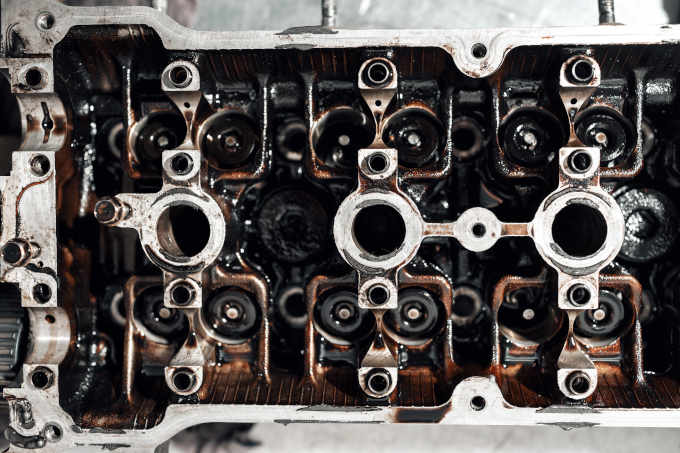You might never have thought that among the many issues a car engine can experience, an excess of “engine sludge” would be one of them. So, what is engine sludge, and how might it affect your car? These are the core questions we will address in today’s blog.
What is Engine Sludge?
Engine sludge— also known as oil sludge—is contaminated engine oil that forms as a result of contact with oxygen that starts to convert the oil from its natural dark liquid form into a more viscous and gelatinous substance that sticks to the engine rather than flowing through it.
This sludge tends to form most commonly around an engine’s crankcase and can eventually build up to the point where it becomes a serious problem. Besides oxidation, engine sludge will also form as oil gets older and more contaminated through its regular use, losing purity to grit, dirt, metal shavings, and other contaminants that oil collects as it lubricates and cools the engine. It gradually thickens with these new materials and eventually becomes problematic engine sludge.
What Does Engine Sludge Do to Your Car?
Motor oil is the lifeblood of your car and engine. A failure to properly maintain the quality and condition of the oil will lead to disastrous results. Engine sludge can block up key parts of the engine, preventing good oil from getting through.
When engine sludge is left unattended, it will result in total engine failure sooner or later. At that point, your engine would need to be reconditioned by a professional, which would be both expensive and time-consuming to do.
Symptoms of Engine Sludge
So, how might one know that they are experiencing a buildup of engine sludge without actually getting up close and personal with the engine?
1. Dashboard Warning Lights Appear
The most common first sign is that dashboard warning lights may light up. The Check Engine Light (CEL) or your oil pressure warning light (the yellow oil can) may illuminate on the dashboard.
If you see one or both of these light up, you need to let an auto technician take a look with an OBD-II scanner and determine what’s wrong.
2. Falling Gas Mileage
When your engine oil gets sludgy, it’s harder for it to work its way through the engine to provide cooling and lubrication. To compensate, the engine will work harder to make it happen, which burns up more gasoline and leaves you with a weaker fuel economy overall.
If you’ve noticed that you’re running out of gas faster than you’re used to, and nothing significant has changed in your driving habits, then something is likely wrong with the mechanics of your vehicle. One possibility is a buildup of engine sludge. That buildup is even more likely if it has been more than 5,000 miles since your last oil change.
3. The Engine is Overheating
When oil turns to sludge and can’t do its job correctly, engines can overheat. That’s because a sludge-filled engine is one where metal moving parts are grinding over one another without oil lubricant, generating more friction and thus causing the engine of the vehicle to overheat.
4. Clicking Noises
The sludge buildup will typically concentrate around the tappets and hydraulic jacks. The sludge builds to where these components can’t move freely as they usually need to, but they still try, which generates a clicking noise. If you hear a rhythmic clicking noise after turning on the engine, then sludge could be blocking oil galleries and preventing the rams and springs from getting the lubrication that they need.
What to Do About Engine Sludge
If you discover that your engine has a sludge buildup, here are a few courses of action.
See a Professional Auto Technician
The best thing you can do is take the car to a professional mechanic to see what can be done to save and recondition the engine. If there is only minor sludge buildup, the engine can be cleaned, flushed, and replenished with fresh oil. When it’s more serious, however, the mechanic will have to disassemble the engine to see the extent of the problem and what they can do to resolve it.
Don’t Ignore Dashboard Warning Lights
As mentioned above, it’s important that you see a mechanic right away if you see the oil pressure warning light or the Check Engine Light on. The appearance of either of these lights doesn’t automatically mean that you have an engine sludge problem, but it means there’s something wrong enough to warrant a warning and recommend that a mechanic take a look.
Avoid DIY
Given that engine sludge buildup often needs the engine to be dismantled to get to the heart of the problem, it’s not a good idea to try and fix the problem yourself.
Ways to Prevent Engine Sludge
There are four main courses of action one should take to avoid the dismal faint of an engine overcome by sludge:
- Get regular oil changes according to the recommended mileage interval recommended by the oil manufacturer. Older models use regular engine oil, which must be changed every 3,000-4,500 miles. Newer cars use better synthetic oils that can last over 10,000 miles.
- Spending too much time in stop-and-go traffic jams is a surefire way to accelerate the development of sludgy oil. Try to find alternate routes if possible, or set off to your destination at an earlier time to avoid traffic.
- Never ignore warning lights or dismiss them as the engine being “too sensitive.” A warning light warrants a professional check.
- Invest in the best possible oil that your vehicle can use. Higher-grade oils last longer and resist the process that turns them into sludge. If your mechanic has a recommendation for better oil, go along with it.
Call in the Pros at AAMCO SoCal
Bad oil waits for no one! If you think your vehicle might be experiencing a problem with engine sludge, then contact a Southern California AAMCO Center near you and schedule an appointment today!
AAMCO has more than 60 years of experience diagnosing, servicing, and repairing more than 20 million vehicles. Customers rely on us for:
- Quality repairs
- Expert technicians
- Superior customer experience
- Trustworthy, honest service
- Best warranty coverage available
AAMCO Centers of Southern California and surrounding areas represent trust, quality, and value. If you’re having cooling system trouble, call us today!

 Schedule Appointment
Schedule Appointment















